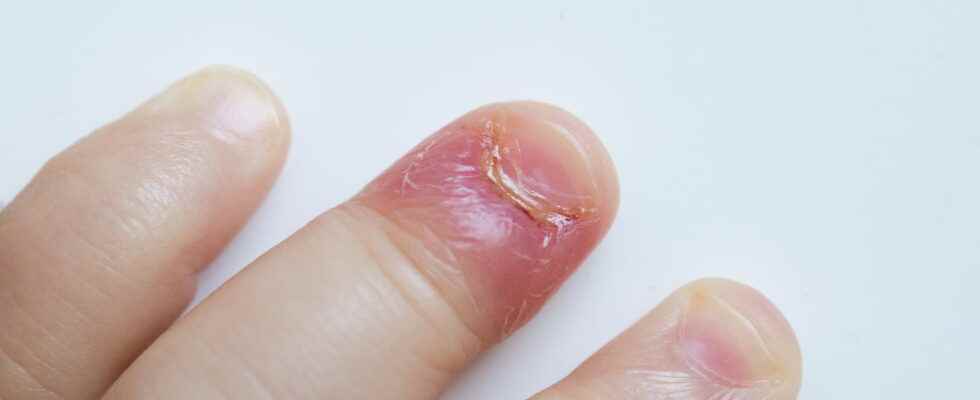On the finger of the hand or the toe, paronychia is a painful bacterial infection most often due to staphylococcus aureus. Advice from our dermatologist to take care of it correctly.
“paronychia is a skin and subcutaneous infection a finger on the hands or feet“, says Dr. Nina Roos, dermatologist in Paris. The infection is most often due to Staphylococcus aureus. The finger becomes red and swollena sign of inflammation. A small lump of pus may also appear after 2 or 3 days. This infection can vary in depth and size. This infection is often mild, but it must be treated to avoid any complications, including spreading to other tissues such as tendons, for example.
The inflammation is frequently located near a fingernail, most often secondary to a wound or a nail of the hand or feet cut too short. If the infection is allowed to progress, there is also an accumulation of pus and a painful white swelling appears. In the early stages, dressings moistened regularly several times a day help to “ripen” the paronychia and prevent its development. In the purulent stage, the treatment consists of cleaning the wound of all its pus. Poorly cared for, whitlow can reach the deep areas of the toe and cause damage to other structures such as tendons or bone, and surgery may be necessary.
Paronychia can present and develop in three different stages.
- In the inflammatory stage, the inflamed area is hot, swollen and painful to the touch.
- In the second stage, the symptoms are much more important, and the pain becomes overwhelming. The collection of pus is visible, and a mild fever may appear.
- In the third and final stage, the infection spreads to nearby tissues, and causes inflammation in the skin, joints, tendons and bones.
Without treatment, a superficial paronychia can spread deep and lead to infection of the bone (osteitis), joints (arthritis) or skin (cutaneous necrosis). These complications can sometimes, in extreme cases, lead to partial amputation of the finger or toe.
“Paronychia is caused by an infection of the skin around the nail by bacteria, most often staphylococcus aureus or streptococcussays Dr. Roos. The germ penetrates through a wound and develops in a few days“. Generally, paronychia is a bacterial infection often linked to a wound that becomes superinfected, especially in those who bite their nails or who have cut their nails too short.
The bacteria present in the pus are a source of infection for weakened skin or for the eyes. “It is recommended to avoid rubbing your eyes, taking care of a baby, taking care of a child or a person with fragile skin without washing your hands thoroughly.“, advises Dr. Roos.
A hard paronychia 5 to 10 days depending on how quickly the pus will succeed in evacuating. The pain stops as soon as the evacuation of the pus is done, it does not persist after recovery.
Observing the hand allows you to precisely locate the infection, and its red, warm and swollen appearance is an excellent indication. When the skin is usually raised by a small pocket of whitish and very painful pus, the infection has been present for a few days. If the infection has been going on for a long time, an x-ray should be done to make sure it has not yet migrated to nearby tissues.
Better not touch his paronychia. “You can possibly pierce yourself a collection of yellow pus that you would see forming near the nail, but this gesture is useless as long as there is no visible pocket of pus “, says the dermatologist. As long as the skin is red and tight, there is no liquid to evacuate, so piercing is useless at this stage, and even risky since you create a breach and an infectious gateway to an already fragile skin area. and vulnerable.
First of all, the first thing to do is check her tetanus vaccination reminders. The treatment is different according to the evolution of the paronychia.
Paronychia without abscess
When there is no abscess, the cleaning the wound and antiseptic baths to repeat several times a day, are enough. It is of course necessary to monitor the evolution of the infection. With a beginner paronychia, it is enough to clean the wound, if it is still visible. In addition, the application of moist dressings generally makes it possible to “ripen” the paronychia and to reduce its evolution, preventing the passage to the collected stage.
Paronychia with purulent abscess
In case of purulent abscess, the infected area should be excised by a practitioner: removal of pus and infected tissue. Antibiotic treatment may be prescribed if necessary.
Surgery
In case of failure of medical treatments, an excision of the treated area will be recommended. “This intervention is performed in the operating room, in outpatient surgerysays Dr. Roos. It involves removing damaged tissue..
Bleach or not?
This grandmother’s remedy consists of soaking her paronychia in diluted bleach. “It’s a bad idea, says our expert. Highly corrosive, bleach may damage fabrics even more and cause great pain. Better to disinfect the wound with Hexomedine“.
- Avoid cutting it too short. A white edge should remain to protect the skin.
- Wear gloves during your DIY or gardening sessions to avoid injuries
- Avoid wearing shoes that are too tight at the toe.
- Also wear cotton socks and avoid contact with irritants and allergens.
Thanks to Dr Nina Roos, dermatologist in Paris.
